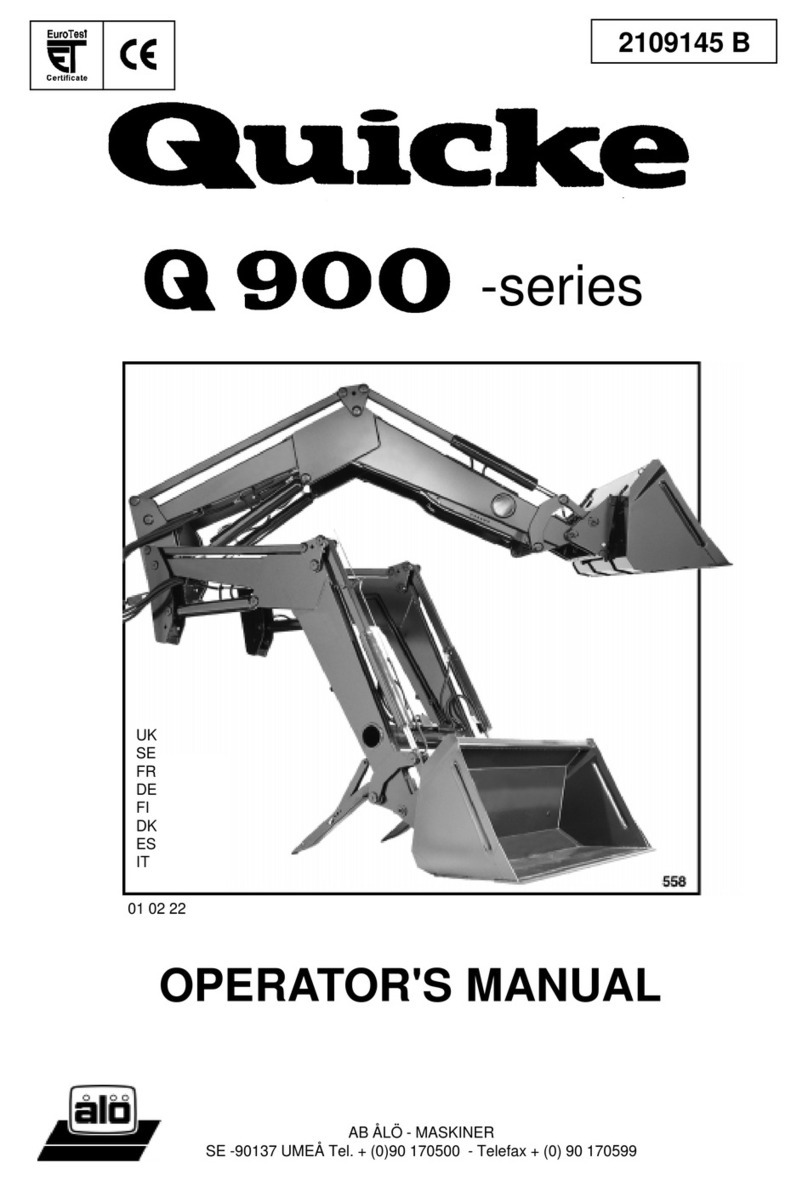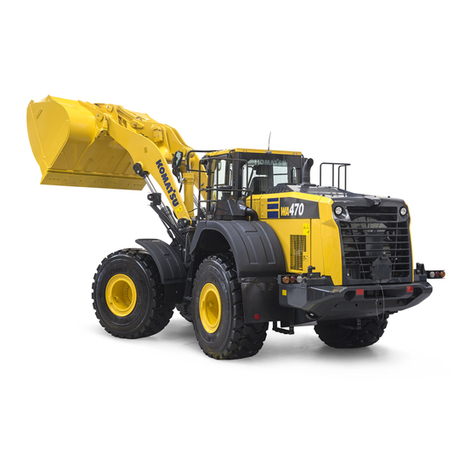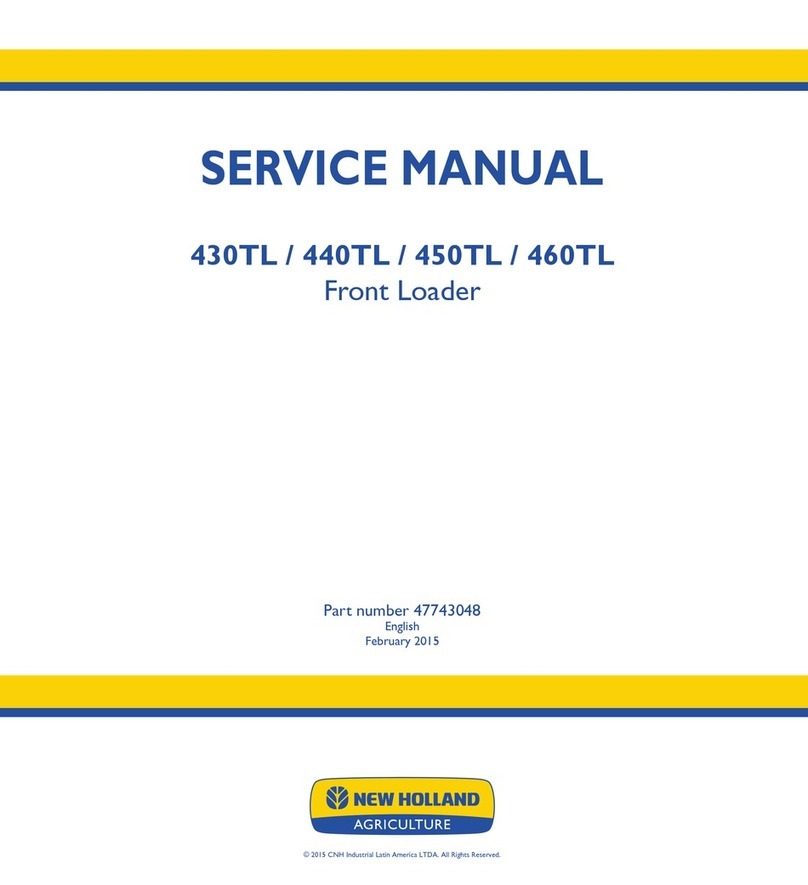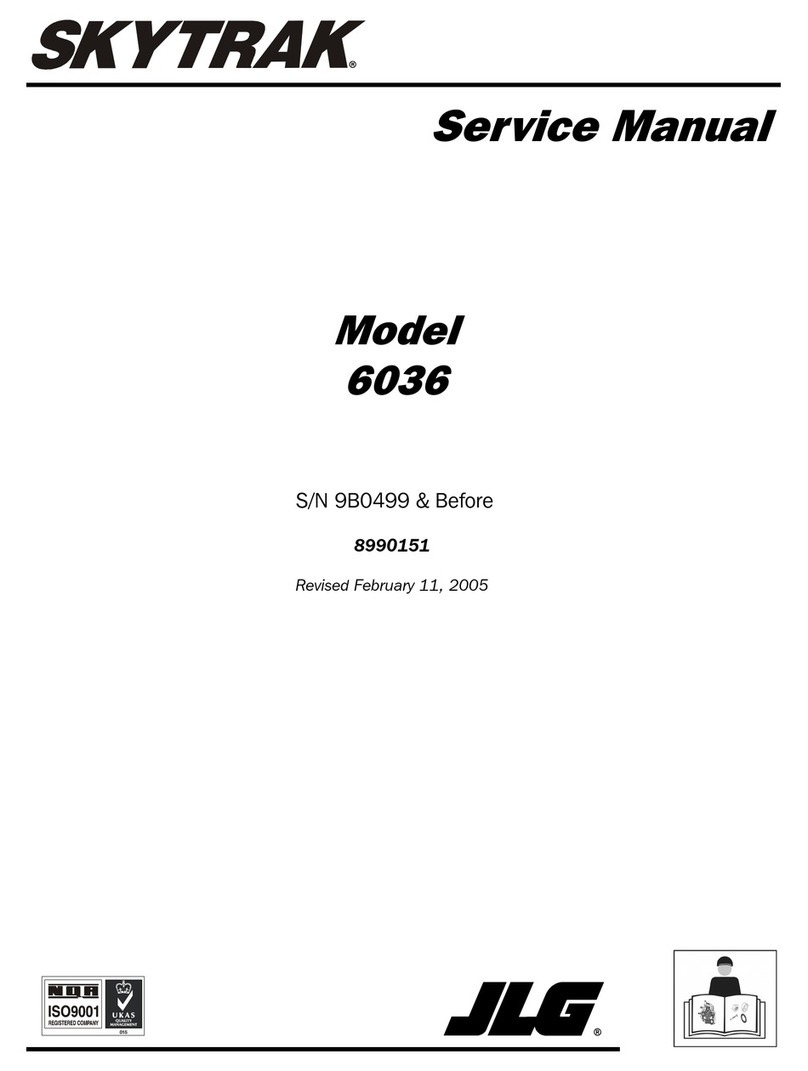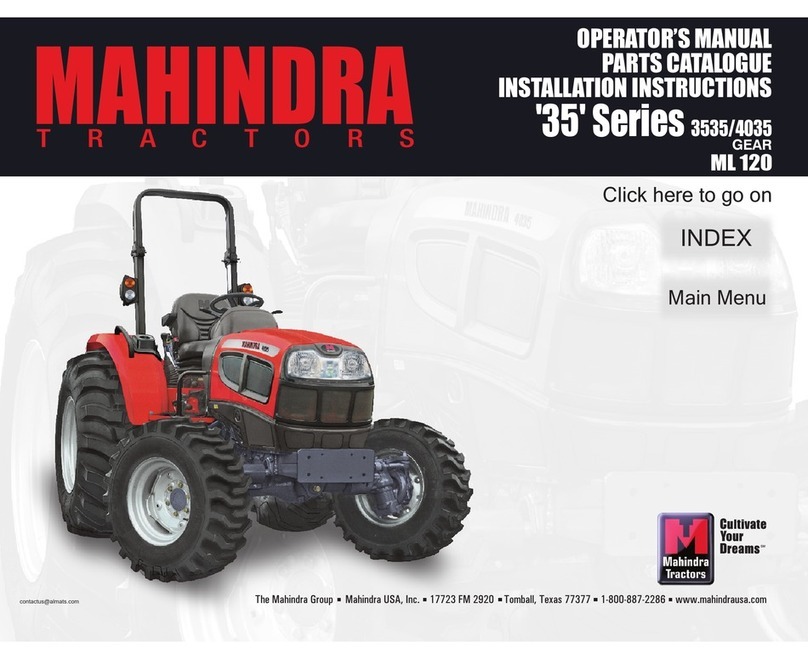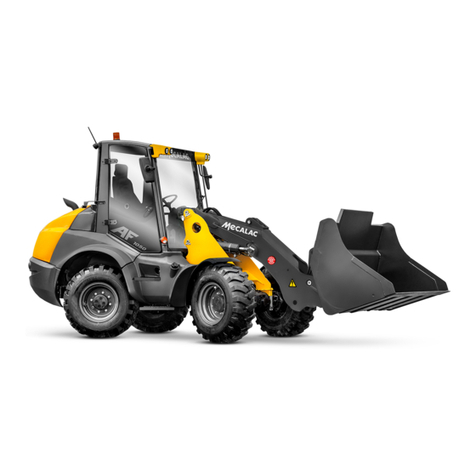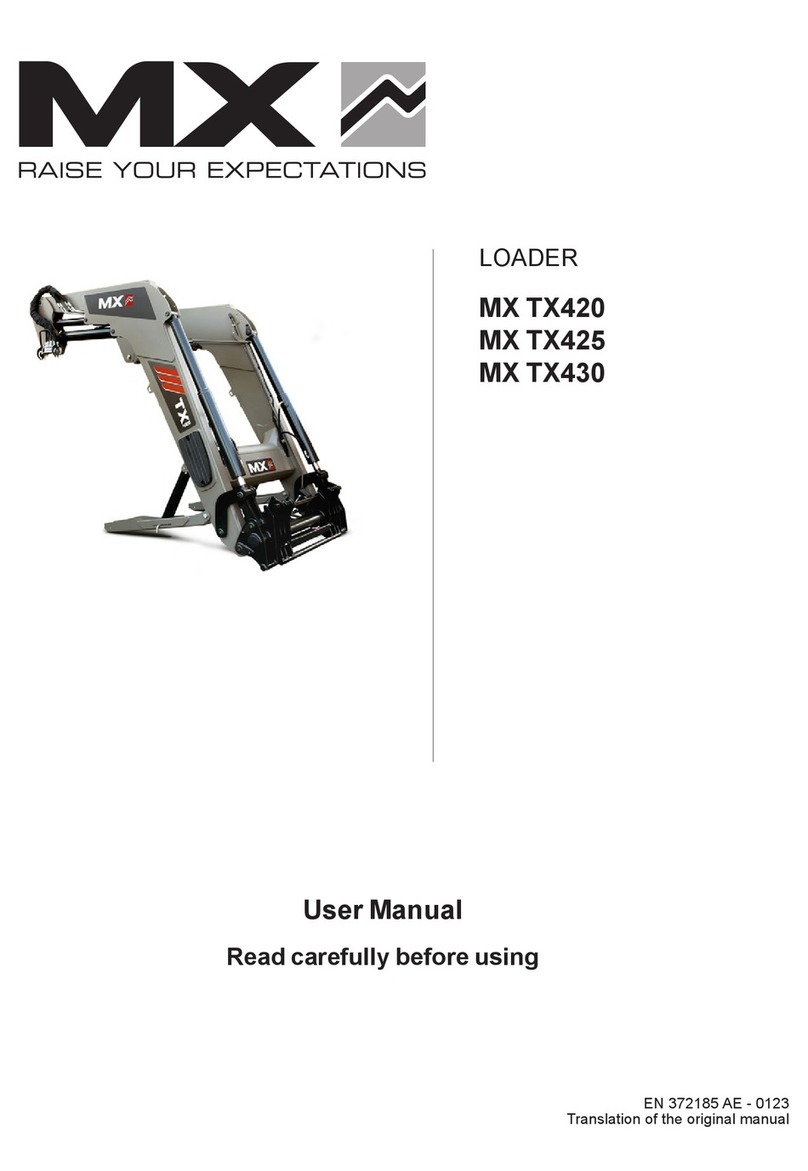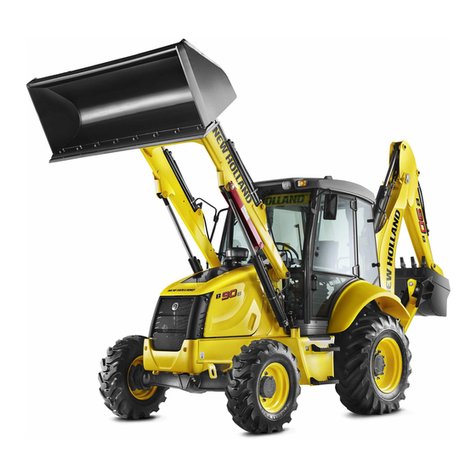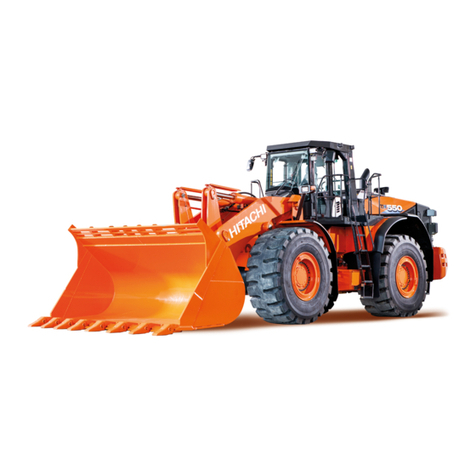The Frank G. Hough HA PAYLOADER 23500 User manual

OPERATING MANUAL
FOR
MODEL HA PAYLOADER®
BEGINNING WITH SERIAL NUMBER 23 SOO
FORM HA-SO-A
MANUFACTURED BY
, H E F RAN
K G. H 0 UGH CO.
LIBERTYVILLE, ILLINOIS
LITHO. IN U. S. A.
JAN. 1952
---------~----------- ---~-

TO THE OWNER
It
has been our aim to build the most reliable and serviceable shovel on the market.
Hough shovels have, since 1920, built a reputation for dependable and economical service in the material
handling field. This "PAYLOADER" includes all these features which have made possible long, dependable
service, together with the latest engineering knowledge and design.
The purpose of this manual is to explain maintenance requirements and routine adjustments which are
necessary for the most efficient operation of your "PAYLOADER". To protect your "PAYLOADER" invest-
ment, study this manual before starting or operating your "PAYLOADER".
If
you should need information not given in this manual, or require the services of a trained mechanic,
we urge you to use the extensive facilities offered by THE FRANK G. HOUGH CO. "PAYLOADER" dealers.
Dealers are kept informed on the best methods of servicing and are equipped to provide prompt, dependable,
service in the field or in an up-to-date service shop.
Dealers carry ample stocks of THE FRANK G. HOUGH CO. essential "PAYLOADER" parts.
Listed below you will find the name of THE FRANK G. HOUGH CO. dealer with whom your parts orders
should be placed and who should be called upon for any required information concerning proper operating and
maintenance procedure.
OUR "PAYLOADER" DEALER 15: _
When ordering parts always give THE FRANK G. HOUGH CO. "PAYLOADER" dealer both the name and
part number of the part required, and also the serial number of the "PAYLOADER".
IT IS THE POLICY OF THE FRANK G. HOUGH CO. TO IMPROVE ITS PRODUCTS WHEN-
EVER POSSIBLE AND PRACTICAL TO DO SO. WE RESERVE THE RIGHT TO MAKE
CHANGES OR ADD IMPROVEMENTS AT ANY TIME WITHOUT INCURRING ANY OBLIGA-
TION TO MAKE SUCH CHANGES ON MODELS PREVIOUSLY SOLD.
WARRANTY
This Model HA "PAYLOADER" is warranted free from defects of material or workmanship for a period
of six months from date of sale: it is further warranted to be mechanically practical for the purpose advertised
by THE FRANK G. HOUGH CO.
Parts claimed to be defective are to be reported to us promptly and returned to us with transportation
charges prepaid.
If
we find the parts defective upon our examination, credit will be issued or the parts re-
placed.
This warranty will not apply to machines that have been misused, loaded beyond factory rated capacity,
neglected, or damaged through accident.
Any expense incurred without authorized consent for repairs or replacements will not be allowed The
use of any but THE FRANK G HOUGH CO. parts nullifies this warranty. •

NAME PAGE
APR
9
1956
TABLE OF CONTENTS
TO THE OWNER. . . . . . . . • . . . . . . Inside Front Cover
SPECIFICATIONS
&
SERVICE DATA. 2
&
3
PREPARATION FOR OPERATION. 5
OPERATING THE "PAYLOADER" 6
Foot Pedal . . . . . 7
Hand Levers. . . . . 6
Dash Instruments. . 7
Starting the Engine. 7
Driving the "Pay1oader" 8
Routine Service. • . . • • 9
Cold Weather Operation. 9
Draining the Cooling System. 9
MAINTENANCE SECTION. . . . . . . . . . . . 11
Hydraulic Diagram
&
Care of System. 11
Draining the Hydraulic System. . ... 12
Bleeding the Hydraulic System. . . . 12
Hoist Cylinders - Hydraulic Packing 12
Oil Reservoir - Hydraulic 13
Pump - Hydraulic. . . . . . • . . • . . . 15
Valve _ Hydraulic. . . . . . . . . . . . . 13
Pressure Relief _ Hydraulic Valve.. 15
Engine. . . 19
Fan Belt. . . • 19
Oil Filter. • • 20
Air _ cleaner. 20
Clutch - Adjustments 20
Drive Shaft - Universal. 21
Transmission. . . . • • 21
Drive Axle . • • • . . . • 21
Brakes _ Adjustments. 23
Stee ring Gear . . . . . . 24
Steering Adjustments - Toe In 25
Tires. . . . . • . . . • • . 25
Bucket - Cutting Edge. 26
Wiring Diagram. . • • . 18
LUBRICATION POINTS
&
CHART. . . . . • . . . . . . . . • . . . . . 28-29-30

CONDENSED SPECIFICATIONS &SERVICE DATA
ENGINE:
No. Cylinders.
Bore .
Stroke .
Displacement .
Speed (Governed).
Horse Power ..•
4
3-1/ 4"
4"
133 cu. in.
1800 R.P.M.
29
Complete with electrical starting equipment, oil bath air cleaner with cen-
trifugal type precleaner and engine oil filter.
TRANSMISSION:
Two speeds forward and two speeds reverse, completely equipped with
anti-friction bearings.
FINAL DRIVE:
Heavy duty double reduction spirafbevel and spur gear design. First
reduction spiral bevel with differential ahead of final drive. Full floating
axle shafts. Completely equipped with ball and roller bearings.
CAPACITIES:
Cooling System ...
Fuel Tank System.
Transmission Case
Final Drive Differential Case
Crankcase ...•
Hoist Reservoir .....
3-1/2 gal.
6-1/2 gal.
4-1/2 pints
5-1/2 pints
5-quarts
6 gal. approx.
BUCKET: STANDARD
Width .
Capacity, Volume
Capacity, Weight.
48
12 cu. ft.
10001bs.
CLUTCH:
12" Spring Loaded, Single Plate Dry Disc.
2

CONDENSED SPECIFICATIONS &SERVICE DATA - CONCLUDED
BRAKES:
12" x 1-3/4" - INTERNAL EXPANDING HYDRAULIC BRAKES ON
BOTH FRONT DRIVE WHEELS.
Front (Drive Wheels)
Rear (Steering Wheels) 7.50
x
16
6:00-9 8 Ply - 50 lbs. Air Pressure
6 Ply - 55 Ibs, Air Pressure
STEERING:
Heavy Duty Truck Recirculating Ball Type Steering Mechanism.
PNEUMATIC TIRES:
Overall Height .
Overall Width ..
Overall Length.
Turning Radius.
Wheelbase ...•
Floor Clearance.
5' -
1-1/8"
4' - 2-1/4"
10' - 1"
6' -
11"
3' - 10-1/4"
0' - 5"
"PAYLOADER" DIMENSIONS: Bucket in carry position.
WEIGHT:
"PAYLOADER" EMPTY "PAYLOADER" WITH 1000 LBS. IN BUCKET
Front 2590
Rear 1970
Total 4560
Front 4560
Rear 1000
Total 5560
Variations in bucket size s can be supplied to meet special conditions.
n
3
-

:r::
u
t-
~
if)
z
Q
s
0:::1<
wO:::
>t-
w""
_J"-'
z
"-'1
00
Cl:;;;
20
<_J
0:::
:r::'
Cl
-;s
Fig. 1
Operating Control
4
(f)
:r::
_j
t-
O
:;;;
0:::
...::>
f-
z
Z
0
U
C)
Z
f-
«
0::
w
<:
Q_
:r::
0
0:::
0
LL

PREPARATION OF THE "PAYLOADER" FOR OPERATION
Before operating this "PAYLOADER", even to
unload, check the entire unit to make sure nothing
has become loose or damaged in transit or storage.
Battery cables have been disconnected at the
factory, and the gasoline shut-off cock closed before
shipment. Machines sent outside the United States
are shipped with a dry battery, and the fuel tank and
fuel lines drained.
DO NOT ATTEMPT TO START THE ENGINE
BEFORE THE FOLLOWING POINTS HAVE BEEN
CHECKED OR DAMAGE MAY RESULT.
Refer to the Lubrication Chart, to locate the
following points.
1. Check the oil level in the Hydraulic System Res-
ervoir to make sure
it
is up to the petcock. The
engine MUST NOT be started without oil in the
Hydraulic System. Use SAE #10 Motor Oil to re-
fill. Drain the hydraulic system after the first
32 to 48 hours of operation and refill with clean
oil. Be sure to clean the suction outlet strainer
at this time.
2. Check the Oil Level in the engine crankcase by
removing the oil dip stick from the side of the
engine.
3. Check the Oil Level in the transmission to be
sure it is to the height of the oil level plug.
4. Check the Oil Level in the differential and both
final drive gear cases. Differential oil level plug
is located in the rear of the housing. Final drive
gear case level plugs are located on the inside
surfaces of both rear wheel housings.
5, Check the oil in the air cleaner cup. Clean and
refill daily or oftener as required. This is
important.
6. Check the Master Brake Cylinder to make sure
it is filled with brake fluid.
If
not, fill with
Hydraulic Brake Fluid.
7. Be sure all hoses and connections are tight to
prevent hydraulic oil from leaking out, and to
keep air or water from entering the system. Water
entering the system will cause pump erosion at
high velocities. Air or water in the system will
cause the oil to foam and the hoist to operate in
a slow, jerky manner.
8. Check the Tire Pressures. Be sure they are up
to pressures recommended in the Specifications
and Service Data Lists.
9. Check the cooling system. Refill with clean, soft
water, free from alkaline; never at any time run
the engine without the full quantity of cooling
fluid in the radiator. Be sure to add a permanent
type anti-freeze solution to the cooling system
during freezing weather.
10. Be sure to open the fuel line shut off cock located
on the fuel line at the fuel tank. The fuel tank is
mounted under the front cowl. Fill the tank with
gasoline ofminimum octane rating of 70-72. Use
a clean container.
11. Be sure all drain plugs, drain cocks, filler open-
ings and fuel line connecti~ns are tight and do not
leak.
12. Connect battery cables and check the dash instru-
ments to be sure they function properly. Check
the batteries to be sure the plates are covered
with water.
If
not, add distilled water or clean
rain water.
13. Do not operate the "PAYLOADER" to capacity
during the first weekly period of operation. Oper-
ate the machine with light loads for the first 36
to 50 hours of actual use.
14. Read the instructions as set forth in this book
carefullybefore attempting to operate this "PAY-
LOADER". The functions and application of hand
levers, foot pedals, and other controls, differ be-
tween various types of similar machines, and
their use should be understood by the operator
before attempting to start the engine.
15. Grease the "PAYLOADER" daily (every 8 to 10
hours of operation). Use the lubrication chart
and the Engine manual as a Guide, When it is
properly serviced and checked, and its method of
operating understood, the machine may be put to
work.
5

OPERATING THE "PA YLOADER"
Before starting the engine, read the following
paragraphs carefully to become acquainted with the
location and the functions of the instruments and con-
trols. Always be sure all levers are in neutral posi-
tion before pressing the starter button. Since the
hydraulic pump is coupled directly to the engines, the
boom and bucket may be operated as soon as the en-
gine is started.
Refer to the Operation Controls picture to note the
location of the levers and pedals.
When learning to use a machine of this type,
it
is
well for the operator to work carefully, taking his
time, to gradually become accustomed to the machine.
Operating speed and skill will be sttained easier by
slowly acquiring the "feel" of the "PAYLOADER".
The time used in learning may be well spent in pre-
venting possible accidental damage to the machine or
operator, and to safe guard other personnel. The
main factor in the performance of any machine of this
type lies with the operator.
A careful operator is the best insurance against
an accident. Never leave the machine without first
lowering the bucket so it rests on the ground, and
making sure all control levers are in neutral position.
Never reach betwe.en the boom and guide bar to
lower the bucket. The bucket may be lowered to the
ground although the engine has been shut off.
The term "right hand" or "left hand" as used in
these pages, are determined by the operator's posi-
tion when sitting in the seat and facing the bucket.
HAND LEVERS:
This "PAYLOADER" is equipped with a twospeed
forward and two speed reverse transmission. The
speed and direction of travel is selected by shifting a
RANGE LEVER and a DIRECTIONAL LEVER. These
FRONT
FORWARD HIGH
NEU.
NEU.
REVERSE LOW
DIRECTIONAL
LEVER RANGE
LEVER
GEARSHIFT DIAGRAM
levers are located at the right side of the steering
column. See the Operating Controls picture.
DIRECTIONAL LEVER is the longer lever adja-
cent to the right side of the steering column. Shift
this lever to drive the machine in a forward or re-
verse direction. Push it forward to shift the trans-
mission into forward gear. Pull it backward toward
the operator to shift the transmission into reverse
gear. This lever is in neutral when in its central
position.
RANGE LEVER is the shorter lever next to the
directional lever on the right side of the steering
column. The speed of travel is selected by shifting
the range lever. The transmis sion is in neutral when
this lever is in its central position. Push this lever
forward, ahead of neutral, to shift the transmission
gears into low speed range. Pull it backward from
neutral to shift into high speed range. The low speed
range is used for working conditions in which more
power is needed. The high speed range is used pri-
marily for transporting loads to various locations.
Always be sure the range lever is in neutral
before the engine is started or when leaving the
machine.
NOTE: Always depress the clutch pedal when
shifting either the range lever or the
directional lever. Do not attempt to
shift the transmission gears while the
machine is in motion.
u
VALVE CONTROL LEVER is located on the left
hand side of the seat. By use of this lever, the oper-
ator controls a valve which regulates the flow of oil
to the bucket and boom hoist cylinders to activate the
bucket.
LOWER
BUCKET
FRONT
J;~~~~iT"~--~~----__.
DUMP
BUCKET
RAISE
BUCKET
VALVE LEVER POSITION
6

The valve control lever has five positions to
RAISE, LOWER, HOLD (or neutral), DUMP, and
RETRACT the bucket. The valve spools are spring
loaded, causing the lever to automatically return to
"hold" position when the lever is released.
Pull the valve control lever backward, toward the
seat, and the boom and bucket will raise upward, in
direct proportion to the engine speed. Simply release
the lever to stop and hold the bucket at any height of
its travel.
Move the valve control lever inward, toward the
operator, to dump the bucket. Release the lever to
allow it to return to hold position to stop and hold the
bucket in any point of its dumping arc.
Move the valve control lever outward, away from
the operator, to retract the bucket from its dumping
position. When the bucket is fully retracted, allow
the lever to return to neutral.
Move the valve control lever forward, away from
the seat, to lower the bucket.
The faster the engine speed, the faster the bucket
will raise or retract.
FOOT PEDALS:
n
The CLUTCH PEDAL is located on the left side
of the floorboard. Whenpushed down, the transmission
is disengaged from the engine. Always keep the clutch
pedal depressed when shifting either the range lever
or the directional lever. Do not engage the clutch
suddenly, thus allowing the "PAYLOADER" to jerk
with the load.
CAUTION: DONOTDRIVE THE "PAYLOADER"
WITH THE FOOT RESTING ON
THE CLUTCH PEDAL. THIS WILL
CAUSE UNDUE WEAR ON THE
CLUTCH FACING AND THROWOUT
BEARING.
The BRAKE PEDAL is located on the right side
at the floorboard and is used to bring the "PAY-
LOADER" to a stop. Depress the brake firmly when
braking.
It
is good practice to keep the clutch engaged
until the "PAYLOADER" has been slowed down and
nearly brought to a halt by depres sing the brake. Then
disengage the clutch and stop the motion of the machine
completely. This allows the engine compression to
assist the brakes and saves wear on the brake linings.
n
The ACCELERATOR PEDAL is mounted on the
floorboard to the right of the brake pedal. Applying
pressure on this pedal increases the flow of fuel to
the engine cylinders by opening the carburetor intake.
This increases the engine speed, thereby accelerating
the motion of the "PAYLOADER". Apply a slight in-
creasing pressure on the accelerator pedal while
releasing pressure on the clutch pedal to allow the
machine to start evenly, without jerking.
The r
ai
smg speed of the booms and bucket is
also governed by the accelerator.
DASH INSTRUMENTS:
The IGNITION SWITCH is on the left side of the
dash panel and is a push-pull type. Pull this switch
out, to "on" position, before pressing the starter
button. When in "on" position, this switch completes
the electrical circuit to the starter switch, to the
coil, and the dash gauges. Always be sure this switch
is in "off" position before leaving the machine to
avoid draining the battery.
Push the ignition switch in, to "off" position, to
stop the engine.
The AMMETER indicates whether the battery is
being charged or discharged.
If
the needle registers
in the discharge range continuously with the engine
running, or when the ignition switch is in "off" posi-
tion, the cause should be investigated to avoid drain-
ing the battery.
The TEMPERATURE gauge indicates the tem-
perature of the cooling fluid circulating through the
engine. Never operate the engine when this gauge
registers the temperature of the engine coolant to be
at the boiling point. Shut off the engine and check the
water circulation to prevent damage to the engine by
over-heating.
The OIL PRESSURE gauge indicates the pounds
pressure of the lubricating oil circulating through the
engine,
If
this gauge fails to register, stop the engine
IMMEDIATELY and determine the cause, or damage
to the engine may result.
The FUSE RETAINER is located near the center
of the dash, and provides a fuse to protect the wiring
system. Inspect this fuse if the ignition system fails
to operate.
The HORN BUTTON, on some machines, is lo-
cated on the dash panel. On other models the horn
button switch is located in the hub of the steering
wheel. Depress the horn button to operate the horn.
STARTING CONTROLS:
The CHOKE ROD for the gasoline engine is
located to the right of the seat. Pull out this rod to
close the choke valve, thereby enriching the fuel
mixture for easier starting. Open the choke valve by
pushing in the rod as soon as the engine starts. Do
not run the engine with the choke valve closed. When
starting a hot engine, do not use the choke, as it will
make starting difficult.
The STARTER BUTTON is located at the right
side of the seat, and when pressed in, it completes
the electrical circuit to the starting motor. Release
pressure on this button as soon as the engine stctrts.
Do not run the starting motor more than 1/2 minute
at a time, alternating between 1/2 minute intervals of
rest.
7

STARTING THE ENGINE: LOADING THE BUCKET:
With the "PAYLOADER" properly inspected and
checked as explained inthe preceding pages, the engine
may be started. Be sure the engine crankcase oil is
upto the "full" mark onthe oil dipstick and the cooling
system is full of cooling fluid. Be sure the hydraulic
reservoir contains the correct amount of oil. Be sure
the fuel line shut-off cock is open and the fuel tank
contains a sufficient supply of fuel.
1. Be sure the speed range lever and the valve con-
trol lever is inneutral position before attempting
to start the engine. Since the hydraulic pump is
coupled directl y to the engine, the hydraulic hoist
may be operated as soon as the engine is started.
To start the engine proceed as follows:
2. Place the ignition switch in "on" position.
3. Press the starter button. Pull out the choke
slightly to close the choke valve for easier start-
ing if necessary.
4. Whenthe engine starts, watch the oil gauge on the
dash to be sure it is registering. Allow the engine
to idle for a time, running without load until it
becomes warmed up. Push in the choke rod to
open the choke valve as soon as the engine will
run on aless enriched mixture. Follow this pro-
cedure whenever the engine is started.
STOPPING THE ENGINE:
To stop the engine, merely push in the ignition
switch to "off" position.
Be sure the valve control lever and the gearshift
levers are in neutral position before leaving the seat
of the machine.
DRIVING THE "PAYLOADER"
Skill in the use of the machine is acquired by
practice and by intelligent observation of the perfor-
mance of the machine. For instance, correct loading
of the bucket can be judged by the sound of the engine,
and the speed of the tractor.
1. Start the engine; when it has been running long
enough to warmuppartially, and oil pressure has
been built up as indicated on the dash gauge, the
"PAYLOADER" may be put to work.
2. Draw backwardonthevalve control lever to raise
the boom and bucket about two or three feet above
the ground.
3. Depres s the clutch and shift the directional lever
and the speed range lever into one of their posi-
tions, depending on direction and speed of travel
wanted.
4. Release the pressure on the clutch pedal while
increasing pressure on the accelerator pedal and
drive to the working area.
Shift to the low speed range when loading the
bucket. Have the bucket fully retracted and hold the
cutting edge at digging level. Drive the machine for-
ward into the bank or stock pile, letting the forward
movement of the machine fill the bucket.
The loading operation is best done on level or
slightly up-hill terrain. The inherent tendency is to
'dig in" when working down grade. Also, backing up-
hill with a heavy load is difficult due to the increased
weight on the drive wheels.
When the bucket is full or the end of the cut is
reached, pull backward on the boom lever to raise the
bucket out of the cut. As the bucket raises it will
crowd forward, into the face of the cut, exclusive of
the forward travel of the machine. This is especially
noticeable when cutting into a bank or stock pile. The
forward movement of the tractor and the bucket tip-
back feature will give a scooping action, similar to a
"dipper stick" shovel, as the bucket raises out of the
stock pile or face of the bank being cut. As the bucket
raises, it tips back to hold a full load with minimum
spillage.
TRANSPORTING LOADS:
When transporting loads, the travel speed of the
machine will depend on the length of haul and the kind
of surface over which the machine must pass. Rough
terrain calls for slow speed.
When the bucket is full, raise the boom to carry
the cutting edge of the bucket about four (4) feet above
the ground. Never transport the machine, loaded or
empty, with the bucket fully raised. The nearer the
ground the bucket is held, the bette r the stability,
especially on slopes or when turning the machine.
Shift the gears into position for speed and direction of
travel desired, and drive the machine to the dumping
location.
DUMPING THE BUCKET:
When dumping into a truck or bin, raise the
bucket so it clears the top edge safely. Move the
machine up so the bucket is inside the dumping area.
With the boom lever in the hold or neutral position,
push forward slowly on the bucket control lever, thus
causing the bucket to tip forward and spill its load.
The load may be dumped entirely or part at a time,
by manipulating the bucket lever. Dumping the load
slowly will ease the shock of suddently added weight
to a truck body. Releasing pressure on the bucket
control lever will allow it to return to neutral, holding
the bucket in dumped position. Pull backward on the
bucket control lever, to return the bucket to closed
position, before backing the machine away from the
dumping area. Back the machine well away from the
truck or bin and lower the bucket to carry position
[about
four (4) feet above the ground) before returning
the machine for another load.
8

of the "PAYLOADER".
If
alcohol is used, test the
strength of the solution with a
hyd
rornet er several
times a day.
It
will be necessary to add alcohol fre-
quently to replace that lost by evaporation.
ROUTINE SERVICE:
The operator's job does not consist of merely
working the "PAYLOADER". The mechanical and
operating condition, as well as the general appearance
and maintenance of the machine, is also a part of his
responsiblity.
It
is to the operator's advantage to
become familiar with the functions of each working
part, and a study of the information and suggestions
as set forth in this manual will help him do so.
The operating life of the "PAYLOADER" may be
considerably extended if the machine is properly
serviced at regular intervals. Often major repairs
or shut downs are avoided if the machine is inspected
regularly, and minor trouble corrected at this time.
Refer to the LUBRICATION CHART for major
points requiring periodic service and inspection.
COLD WEATHER OPERATION:
When operating the "PAYLOADER" in temper-
atures of 32
0
F. (0
0
C.) or lower, there is danger of
the water freezing in the cooling system, and an anti-
freeze solution must be used. To avoid freeze ups in
the cooling system, use a permanent type anti-freeze
solution such as distilled glycerine or ethylene glycol.
1here are several standard reliable anti-freeze
solutions on the market which may be used in the
cooling system. They should be added to the radiator
according to the manufacturer's instructions found on
the container. See Specification Data list for cooling
system capacities.
Do not use a calcium chloride solution or any
alkaline solution as an anti-freeze, as they are inju-
rious to metal. Do not use fuel oil or kerosene as an
anti-freeze as they are injurious to rubber hoses.
Do not use alcohol as an anti-freeze solution, as
it tends to boil away at average operating temperatures
If
no anti-freeze solution is used in freezing
temperatures, there is danger of the water freezing in
the cooling system, although the engine may be run-
ning, and damage to the engine block, radiator and the
water pump may result.
Never pour cold water in a hot engine, as the
sudden contraction may cause the engine block to
crack.
DRAINING THE COOLING SYSTEM:
To drain the cooling system first remove the
radiator cap, then open the radiator drain cock and
the engine block drain cock. The radiator cap is a
pressure type and must be removed to permit drain-
ing.
The cooling system should be flushed out season-
ally, before adding anti-freeze solution and when
draining out the anti-freeze solution, to avoid accu-
mulations of dirt and gum in the radiator tubes.
GASOLINE TANK:
The gasoline tank is located at the front end of
the "PAYLOADER", under the front cowl. Use a
gasoline of minimum octane rating - 70 to 72 - wher
filling the tank. Be sure to use a clean container.
The gasoline shut-off cock is located on the un-
derside of the tank, approximately midway between
the foot pedals. It is good practice to close this cock
when the machine is to stand idle over night or longer.
The gas tank filler cap protrudes above the front
cowl at the forward end of the "PAYLOADER".
9
-

i~
f
I
o
w
~\~I
20\'
~lw8
~::t:
if>
Fig. 2
Hydraulic Diagram
10

MAINTENANCE SECTION
Regardless of the care used in the design and
construction of any type of equipment, there are many
conditions that can not be completely safeguarded
against without interfering with reasonable ac cess
i-
bilityand efficient operation. The complete observ-
ance of one simple rule would prevent serious in-
juries each year. That rule is --
"NEVER ATTEMPT TO CLEAN, OIL, OR ADJUST
A MACHINE WHILE IT IS IN MOTION."
- - National Safety Council
NEVER WORK UNDER THE BOOMS OR BUCKET
UNLESS THEY ARE BLOCKED AND CANNOT BE
LOWERED ACCIDENTLY.
The following paragraphs are not intended to
cover all repair problems that may confront the op-
erator. They are merely intended to assist the me-
chanic or operator in routine adjustments and main-
tenance which may be done in the field for the most
efficient operation of the machine.
For major repairs, refer your problems to THE
FRANK G. HOUGH CO. DISTRIBUTOR to obtain the
service of a trained mechanic.
HYDRAULIC SYSTEM - CARE OF:
The hydraulic system consists of an oil reser-
voir, a pump, a control valve, two boom hoists, one
bucket control cylinder and the connecting hoses and
fittings.
The pump draws oil from the reservoir through
the suction line and forces it under pressure into the
control valve which regulates the flow of oil to the
hoists, which activate the bucket. The valve is man-
ually controlled by the operator by means of the valve
control lever.
The pump is protected against severe overloads
by a pressure relief built into the valve.
1. Check the oil level in the reservoir daily. The
bucket should be fully retracted and resting on the
ground when checking the oil level. Low oil level
will cause cavitation and the unit will operate in
a slow, jerky manner and the pump will howl.
Proper oil level must be maintained to displace
the hoist pistons when the bucket is operated and
to provide constant lubrication to the pump gears.
2. Check the hoses and connections daily to prevent
oil from leaking out and air or water from being
sucked into the system.
Air or water may be sucked into the system
through a faulty connection, although oil will not
leak out. Air in the system will cause the oil to
foam and interfere with the smooth action 'of the
boom and bucket. The unit will be noisy and the
pump will howl.
The very small amounts of water in the system
through condensation will evaporate when the oil
becomes warm by operation. However, water
sucked into the s y s t e m must be removed by
draining the system, or it will cause corrosion
and erosion of the pump and hoist plungers.
Moisture causes excessive foaming of the oil, and
causes damage to all parts of the system. Foam-
ing will cause the unit to chatter and be noisy.
Drain the system thoroughly to remove moisture.
3. A dirty suction line strainer will retard the flow
of oil, causing cavitation, and the pump will be
noisy.
It
will prevent the "PAYLOADER" from
operating smoothly, similar to air in the system.
4.
Check the hydraulic oil pressure at each monthly
inspection period. Keep the pressure relief valve
set to maintain hydraulic oil pressure within
specified limits. This is important for efficient
operation and relieves strain on the machine.
See "VALVE PRESSURE RELIEF".
5.
Drain the oil from the system, clean the suction
line strainer in the reservoir, and refill the sys-
tem with a good grade of SAE-IO Motor Oil after
the first 32 to
48
hours of actual operation.
There -after, drain the system and clean the suc-
tion line strainer every 1,000 hours or oftener if
working conditions are unusually dirty and dusty.
Dirt in the hydraulic system is a common cause
of failure of the pump or valve.
In hot weather or when the "PAYLOADER" will
operate in temperatures above 90
0
F., it may im-
prove the operation by refilling the system with
a good, clean grade of SAE-20 Motor Oil. Do not
use SAE-20 oil in moderate temperatures.
6.
Drain the hydraulic system only after the "PAY-
LOADER" has been operated for a time and while
the oil is still warm. Warm oil will drain more
freely and carry more impurities out with it.
7.
Use a good clean grade of white lead, Aviation
Permatex or isoluble plastic lead seal, on the
male
th
reads only, when reconnecting a fitting or
joint. Do not allow the thread sealer to enter the
valve or pump.
8.
The system must be "bled" or purged of air after
any work has been done on it, or after it has been
drained.
11

DRAINING THE HYDRAULIC SYSTEM:
NOTE: DRAIN IMMEDIATELY AFTER THE
"PAYLOADER" HAS BEEN OPERATED
FOR A TIME AND WHILE THE OIL
IS STILL WARM. WARM OIL WILL
CARRY MORE DIRT AND SLUDGE
WITH IT.
To drain the entire hydraulic system proceed as
outlined.
1. Raise the boom to full height with the bucket in
dumped position. Block or chain the booms up in
the raised position so they cannot fall when the
oil drains from the hoist cylinders. Then shutoff
the engine.
2. Place a 6 gallon container under the reservoir
drain plug, then remove the drain plug.
The drain plug is a magnetic type and must be
thoroughly cleaned before replacing.
3. After the reservoir has drained, break the suction
hose connection at the reservoir, and break the
pump pressure hose at the valve, to drain the
pump and pump hoses.
4. Break the boom hoist hoses at the tee to drain the
boom hoist cylinders.
5. Break the boom pipe hose connection at the rear
end of the pipe, to drain the bucket control cylin-
der and the boom pipe.
6. Remove the reservoir clean-out cover; reach into
the reservoir to remove the suction line strainer.
The strainer must be washed thoroughly in clean
gasoline to remove all particles of dirt and lint.
7. Remove the cap from the reservoir breather, and
wash it in gasoline to clean the air passages.
8. Flush and clean all sludge and dirt from the bot-
tom of the reservoir, being careful not to force
sludge or dirt into the valve.
If
the reservoir is
very dirty, or
if
dirt is forced into the valve, it
must be removed and the valve washed out in
clean gasoline. Dirt in the valve may result in
wear and failure.
9. After the system has been drained and cleaned,
replace the drain plug, the strainer, and the valve,
and remake all broken connections. Be sure the
connections are tight and will not leak oil or suck
air. See "CARE OF THE HYDRAULIC SYS-
TEM".
10. Refill the system to the top of the reservoir with
a good grade of SAE-10 Motor Oil.
11. Start the engine; allow it to operate at idle speed
until it partially warms up and giving it time to
pump oil into the cylinders. Operate the bucket
cylinder t h r
0
ugh its dumping cycles several
times. Remove the blocks or chains holding the
boom in raised position. Do not stand or work
under the bucket when the blocking is removed.
Operate the boom by raising and lowerixig it sev-
eral times, then allow the bucket to rest, fully
closed, on the ground and shut off the engine.
12. Inspect all connections and the drain plug for
leaks at this time.
13. After all work has been completed, refill the res-
ervoir to the proper level. This is necessary as
oil will have been pumped into the hoist cylinders
and hoses, thereby reducing the oil level in the
reservoir.
14. Replace the clean out cover and the breather cap.
Be sure the cover gasket is in place and the
breather is clean.
15. After the system has been drained and refilled, or
any work done on it, the system must be "bled" or
purged of air, to insure smooth operation of -the
hoist cylinders.
BLEEDING THE SYSTEM:
1. Start the engine, raise the bucket and hold it to
nearly full height, slowly open the bleeder screw
in the upper end of either boom hoist cylinder, to
allow the air to escape.
2. As soon as air bubbles cease to escape
ftom
around the bleeder screw, tighten the screw se-
curely. Clean the hoist cylinder of oil that es-
caped through the bleeder screw. Repeat this
operation on the opposite boom hoist.
Then operate the bucket by dumping and retracting
it to bleed the bucket control cylinder.
HYDRAULIC HOIST CYLINDERS: SEE
FIG. 3.
The Hydraulic Cylinders are so constructed that
no adjustments are necessary other than to tighten
the packing
if
oil escapes excessively.
IMPORTANT: ADJUST THE PAC KING, BY
TURNING THE PACKING NUT.
SO A SLIGHT FILM OF OIL AD-
HERES TO THE PLUNGER, AT
ALL TIMES, AS IT EMERGES
FROM THE CYLINDER.
This comprensatesfor packing
wear and allows the wiper seal to
remove dirt and other foreign mat-
ter from the plunger as it is drawn
into the cylinder.
The hydraulic hoist packing is the chevron type
and is made up in sets of special rings. When the
packing and wiper seals become worn, as evidenced
by oil escaping excessively, they must be replaced.
To replace proceed as follows:
I. Place a container under the tee on the hydraulic
line "valve to boom hoist", and break the hose
connection at the tee to drain the boom hoists.
12

the accumulation of sand, slush or other foreign ma-
terial from sticking to the plungers, thereby length-
ening the life of the wiper rings and the packings.
2. Remove the boom hoist cylinder from the "PAY-
LOADER" and place it in an upright position with
the stuffing box up. To remove the boom hoist,
take out the bolts holding the cylinder to the boom
trunnion. With a chain hoist, lift up the boom and
bucket until the hoist cylinder slips free of the
trunnion. Then remove the cylinder from its
lower frame pivot. Remove the boot to expose
the packing nut.
The bucket control cylinder can be taken from the
machine by removing both the upper and lower
pivot pins which hold this cylinder to the bucket
and to the carrier. Then remove the elbow, nip-
ple and boot from the cylinder inlet connection.
3. Unscrew the packing nut and remove the old
packing using a blunt instrument. Be careful not
to damage the threads in the packing recess or
scratch the plunger rod surface. Pay special at-
tention to the order in which the old packing was
arranged so that the new packing can be inserted
similarly.
Clean out the packing recess thoroughly before
inserting new packing.
4. Replace the rubber wiper ring in the packing nut
at this time. Do not damage the
"0"
ring oil seal
found behind the rubber wiper ring.
5. Insert the new packing rings carefully, in the
same order in which the old packing has been re-
moved. The end ring is a "V" type to fit into the
chevron type rings.
6. Work each ring down smoothly, without distortion
or damage. A damaged ring must be discarded.
Use a blunt ice pick or similar tool to work in the
new r i n g s, Do not damage the stuffing box
threads.
7. There should be 1/16 to 3/32 compression when
the packing nut is screwed in tightly. A properly
adjusted nut will allow a slight film of oil to re-
main on the plunger rod each time it emerges
from the hoist cylinder.
8. Reassemble the hoist cylinders to the machine;
make sure the hose connections are tight.
9. Refill the oil reservoir with proper oil. Start the
engine, let it run at idle speed for a time, then
check the hose connections to be sure they are
tight.
10. Bleed the system of air. After all work is com-
pleted, lower the bucket to the ground and check
the oil level in the reservoir to see that it is to
the correct height before putting the machine to
work.
BOOTS -
Hydraulic Hoists
Boots have been provided to protect the hoist
plungers from nicks, pits and scratches caused by
flying material from the wheels. The boots prevent
It
is recommended that the boots always be kept
in place, and torn or damaged boots be replaced
promptly.
HYDRA ULIC OIL RESERVOIR:
The oil reservoir is located just under the oper-
ator's seat. The oil level must be maintained up to
the petcock level when the bucket is resting on the
ground. This will insure a quantity of'oil sufficient to
displace the cylinder plungers in order to raise the
boom and bucket.
There are no adjustments on the reservoir; how-
ever, it should be drained, cleaned of dirt and sludge
and refilled with clean oil every 1000 hours or oftener
if
working conditions are very dirty and dusty. The
suction line strainer is inside the tank at the suction
line outlet to the pump. This strainer must be kept
clean. A dirty strainer will retard the flow of oil to
the pump and cause cavitation, the pump will howl,
and the boom will raise in a slow jerky manner. The
tank breather should be washed out with clean gaso-
line periodically. Remove the hand hole cover to
reach into the tank to remove the strainer and to in-
spect the vents in the breather pipe.
The oil reservoir may be removed without drain-
ing the oil.
If
draining the oil is necessary, place a
five or six gallon container under the reservoir drain
plug and remove the plug. To take out the reservoir
without draining, remove the hand hole cover, reach
into the tank, and take out the suction line strainer.
Then, using a cork of approximately 31/32 dia. at the
small end, insert it into the suction line outlet of the
reservoir.
To remove the reservoir, proceed as follows:
1. Remove the seat cushion. Disconnect the suction
line hose at the reservoir. Disconnect the pump
pressure hose at the valve. Disconnect the hose
to the boom hoist cylinders at the pipe "Tee".
Disconnect the hose to the bucket control cylinder
at the coupling welded to the frame. The hose
openings may be corked on the valve side to pre-
vent leakage of oil.
2. Remove the choke rod from the machine. Remove
four bolts holding the seat frame to the upper and
lower cross members.
3. Remove the three bolts holding the oil reservoir
to the frame. One is at the rear, right corner,
and the remaining two bolts are in the front,
holding the tank to the frame cross member. The
reservoir may now be lifted from the machine
along with the valve.
HYDRAULIC VALVE:
The hydraulic valve receives oil under pressure
from the pump and directs it to the hoists. When the
13
,-

PACKING WIPER RI~~
I'J
U1 \
1/
===;=~
'0-
RING
BLEEDER
PLUG
ET
o
~~
..:::==-
RETAINING RING GUIDE RING
PLUNGER
Fig. 3
HOIST PACKING DETAILS
BOOM
HOIST
PLUNGER
T
PRESSURE
RE LI EF VALVE
Fig. 4
HYDRAULIC VALVE
14

To check, carefully follow the instructions as
outlined.
valve plungers are in "Hold" position, the oil already
in the hoists is retained therein, but oil from the pump
flows through the valve back to the reservoir.
In
"Raise" and "Close" positions, the oil from the pump
is directed into the respective hoist cylinders. In
"Lower" or "Dump" positions the oil returns from the
hoist cylinders, through the valve and into the reser-
voir along with oil corning from the pump.
No adjustments are to be made other than to re-
move the valve from the oil reservoir and wash it out
with clean gasoline every 1000 hours of operation.
Whenever the oil in the reservoir is very dirty or dirt
is forced into the valve when cleaning the reservoir,
the valve must be removed and washed out. Prema-
ture valve failure or excessive wear is frequently the
result of dirt getting in the valve because of dirty oil.
Springs and seals may be replaced when neces-
sary, but the manufacturer does not recommend re-
placement of the plungers as they have been fitted to
the body at the factory to maintain close tolerances.
The hydraulic valve is mounted to the left hand
side of the reservoir. To remove the valve proceed
as follows:
1. Drain the oil reservoir. Then remove the reser-
voir and valve from the machine.
2. Disconnect the hoses from the valve.
3.
Unscrew the capscrews holding the valve to the
valve mounting plate and the valve will corne away
from the reservoir.
4.
Note the
"0"
ring oil seal at the valve discharge
opening into the reservoir. This ring must be in
good condition, otherwise discard it for a new
ring. Be sure to replace this
"0"
ring carefully
when reassembling the valve to the reservoir to
avoid pinching the ring because of a poor seat.
5. After the valve is bolted to the reservoir, connect
the hoses. Refertothe hydraulic diagram to note
the proper connection points. Be sure the con-
nections are tight and will not leak oil. Replace
the reservoir and valve in the machine. Refill
the reservoir with the proper oil to oil level pet-
cock. Operate the hoists several times. Shut
the engine with the bucket on the ground. Inspect
the connection points, then recheck the oil level
in the reservoir and "bleed" the system of air.
VALVE PRESSURE RELIEF: SEE FIG. 4
To safeguard the pump and to maintain efficient
operation of the machine, the valve pressure relief
must be set to operate at l200lbs. pressure at full
open engine throttle.
Check the valve pressure relief setting to each
monthly inspection period.
1. Insert a hydraulic gauge of approx. 2500 lbs. ca-
pacity into the air bleeder hole in the top of either
boom hoist. The bleeder hole is threaded with
1/2" standard pipe threads.
2. Remove the acorn nut from the valve to expose
the valve pressure adjuster screw. Loosen the
hex lock nut on the adjuster screw. To reduce the
valve pressure relief, turn the adjuster screw
counter-clockwise.
3. Start· the engine, being careful to keep it at idle
throttle. Raise the bucket and booms to full
height. Then, holding the valve lever in "raise"
position, gradually increase the engine speed
while noting the increase of oil pressure. Do
not allow the oil pre ssure to exceed 1200
Ib
s,
If
the oil pressure tends to reach 1200 Ibs, pres-
sure before the engine is running at full open
throttle, slack off the engine speed and adjust the
pressure adjuster screw for lower pressure to
avoid damage. Repeat this process of gradually
increasing the engine speed while adjusting the
pressure relief screw until the gauge registers
1200 lbs. pressure at full open engine throttle
with the bucket fully raised and the valve lever
held in raise position.
When the pressure relief reaches 1200 Ibs , pres-
sure consistently, under conditions as instructed,
the adjuster screw may be locked in place and
the acorn nut replaced.
HYDRAULICPUMP: For Hoists Cylinders: See
Fig. 5.
The pump is coupled directly to the engine crank-
shaft and must not be operated without sufficient oil
circulating through the hydraulic system to provide
constant lubrication in the pump gears. The pump
draws oil from the reservoir and forces it, under
pressure, into the valve.
The pump is a Vickers Rotary vane type, assem-
bled for left hand
ope
ratron, and has no volume ad-
justment.
An
arrow stamped on the body indicates
direction of rotation. Shaft packing is not subject to
pressure and normally does not require replacement.
Vanes, being subject to centrifugal force, automati-
cally compensate for any normal wear.
If
the pump does not develop sufficient pressure
and the cause cannot be determined, see THE FRANK
G. HOUGH CO. DISTRIBUTORfor details on the re-
pair or replacement of the pump.
15

l.J...J
Z
I...D
~z'-.!)
u...JW Z
0::: -
u
I--
I-
ZZ
Q_O:::;'
<C
0:::
0
ULL.2
u
u
>-
LLJ
_J
_J
:::;,
o;
/\
\
"
~
/
~I
~~I
:::;, 0:::
I ----~
o,
01
>-1
Ii
Fig. 5
HYDRAULIC PUMP MOUNTING
16

The hydraulic pump is mounted just under the
radiator and connected to the engine crankshaft by a
flexible chain coupling. To remove the pump proceed
as follows:
1. Remove the pump cover from the lower, rear of
the grille casting by loosening the jam nut and
turning the clamp with a screwdriver. Place the
screwdriver in the slotted end of the clamp stud
and give it a quarter turn to free the cover from
the grille casting.
2. Disconnect the pump hoses at the pump by loosen-
ing the straight adapter unions holding the elbows
to the pump.
3. By using an extension box wrench for a 3/8 bolt,
reach into the grille casting recess and unbolt
the pump adapter plate from the pump mounting
casting. There is one bolt on each side of the
pump, diagonally across from each other.
4. When the pump is loose, draw it straight back-
ward to allow the flexible coupling to slip off the
shaft.
If
the pump is cocked when drawing it out
the flexible coupling may jam on the shaft, making
it difficult to remove the pump. The flexible
coupling is keyed to the crankshaft and to the
pump shaft. Be sure these keys are in place when
reas sembling the pump. The coupling keyslot and
the crankshaft key must be in line to reassemble
the pump to the machine.
PUMP ASSEMBLY - SIDE VIEW
DISMANTLING AND REASSEMBLING PUMP:
Inspection of the pumping cartridge parts in the
vane type single pump can be made as follows:
The pumping cartridge consists of a rotor "E",
vane "F", valve plate bushings "D" and "H", and cam
ring "G". All moving parts, except shaft and shaft
bearings, operate within this cartridge assembly. No
moving parts, therefore, are in contact with the body
"T".
Remove the head screws "A" and the head "B".
The head end valve plate bushing "D" can then be
pulled out, leaving exposed the rotor "E", vane "F"
and the cam ring "G".
Be particularly careful to note the position of the
rotor and vanes, also the position of the ring pin
"p".
These parts may all be reassembled incorrectly
if
not carefully checked, because of the fact that pro-
vision is made in the design for either right hand or
left hand assembly. The position of cam ring "G"
should also be noted carefully.
These parts can all be removed for inspection,
and the shaft end valve plate bushing "H" will then be
exposed. It can be removed by a hook-shaped tool.
Parts that show damage or excess wear should be re-
placed. The vanes can be turned end-for-end so that
the inside edge is now against the cam ring, thus re-
newing the vanes for future service. Worn edges must
be stoned so Vanes move freely in rotor slots and bev-
eled edges must trail direction of rotation.
SMALL END
Of PIN EXTENDS
INTO PUMP
HEAD
HEAD ENDVIEW OF PUMP
WITH PUMP HEAD AND HEAD END BUSHING REMOVED.
PUMP A55EMBL~D
ro
R LEFT HAND ROTAT ION.
BEVELED EDGES Of
VANES TRAIL DI-
RECTION OF
ROTATION
PUMP ASSEMBLY - END VIEW
Reassemble in reverse order with parts replaced
in original positions, using parts drawing as a supple-
mentary guide. Renew head ring packing
"e"
if
it has
become compressed or damaged, otherwise air will
be drawn in when the pump is running or oil will leak
out when not running. Assemble the pump head so
that ring hole registers with protruding end of ring
pin "P".
Extreme caution must be taken when reassem-
bling parts to make certain that no grit or lint gets
into the vane slots or between assembled parts. Not
only may this cause a vane to stick, but it may also
cause damage to valve plate bushings. A small amount
of foreign matter also will give a false indication of
head screw adjustment, thereby impairing pump ef-
ficiency. Wash parts in kerosene and use every pre-
caution against dirt.
When reassembling a pump, the head takeup
screws, if tightened excessively, can cause binding
I 7

LOOM WIRES
~
ENG. OIL
GAUGE
....
ENGINE
Z
O'z:l
..... ....
t:)C!tI
00
~C»
ENG. TEMP
~
GAUGE
==
----------------.._
1
c
MACHINESOF
SERIALNO.S
23951 & UP
STARTER
SWITCH
~
HORN
RELAY
o
"~,
.
MACHINESOF
I _
flr~~ - -
-r
I
SERIAL NO.5
t----'--"-~L_-t3J---+lIII.
23500 THRU23590 / '
/
/'
~
o
o
o
WIRING DIAGRAM
(SCHEMATIC)
FOR HA PALOADERS BEGINING
WITH SERIAL NO.5 23500
c
c
,.
This manual suits for next models
1
Table of contents
